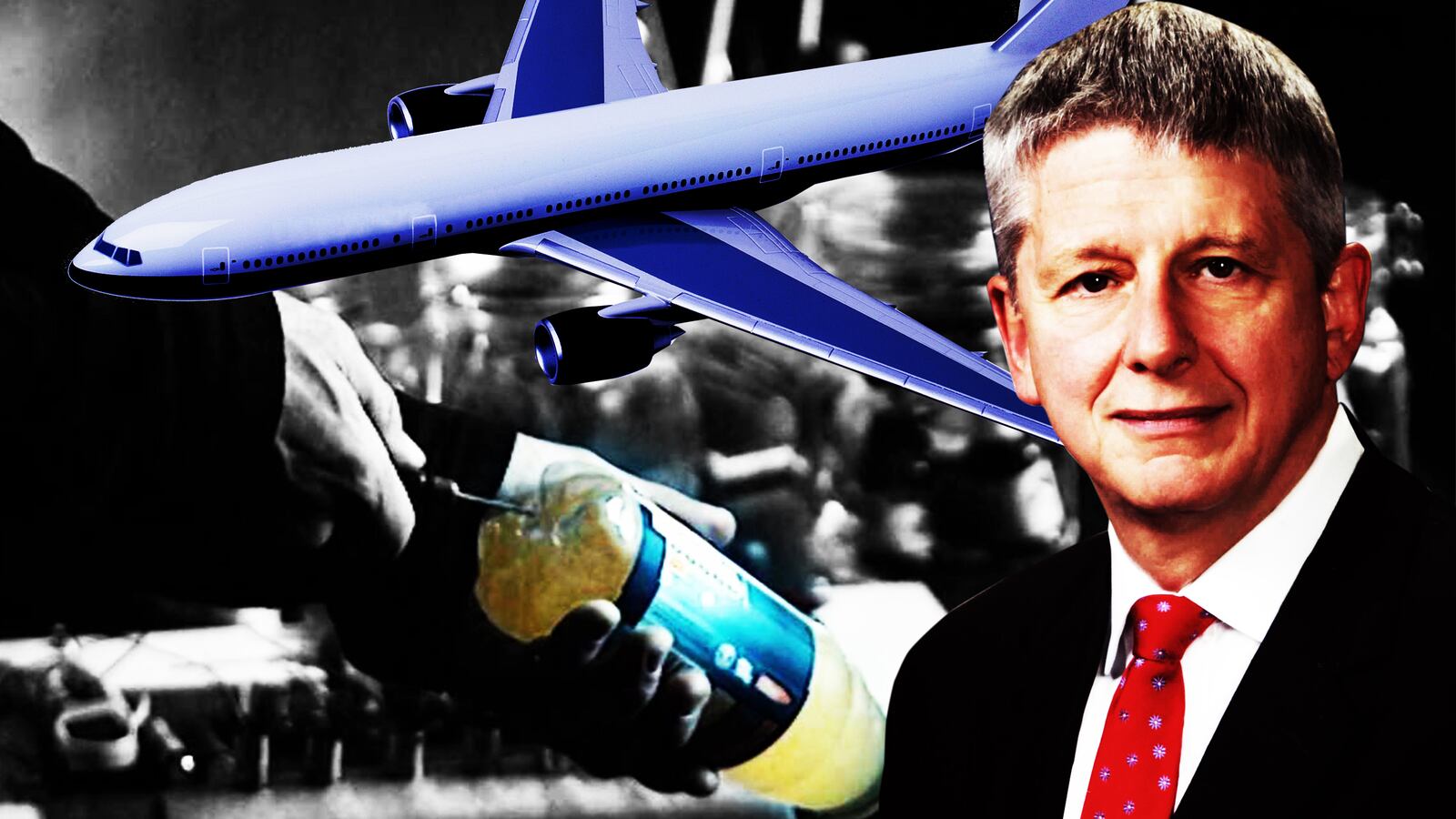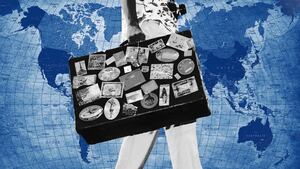Airline travel is a nightmare these days—especially over the holidays—thanks in no small part to the TSA’s exhaustive security measures. And, while most American travelers know why they’re forced to remove their shoes prior to boarding (f*ck you, Richard Reid), far fewer are aware of the reason they’re allowed only 3.4 ounces of liquid per passenger, and must thereby purchase extortionate six-dollar bottles of water.
It’s all due to a complex terrorist mission known as the 2006 Transatlantic Liquid Bomb Plot.
The new docuseries Terrorism Close Calls, now streaming on Netflix, chronicles some of the biggest attempted terrorist attacks that were foiled just under the wire. Its fifth episode is dedicated to the Transatlantic Liquid Bomb Plot, wherein two dozen terrorists planned to smuggle plastic bottles filled with liquid explosives (and other devices) onto seven commercial airliners departing from London’s Heathrow Airport and traveling to North America, assemble the bombs onboard, and detonate them over the Atlantic Ocean.
“The British cell was planning to smuggle those liquid bombs onto planes and blow up seven airliners heading to North America, with at least 1,500 people onboard. That would have made it the biggest loss of life since 9/11,” Mark Kelton, former CIA chief of European operations, tells The Daily Beast. “And if the bombs had gone off over a populated area, the casualties would have gone up exponentially.”
Kelton, a 34-year veteran of the CIA, was one of the central figures who helped thwart this plot. An ex-CIA senior executive, Kelton not only served as chief of European operations for the CIA but also the CIA’s counterintelligence chief. Additionally, he served as chief of CIA ground operations in Croatia, Austria, Russia and Pakistan, and as the station chief in Pakistan helped coordinate the raid that killed Osama bin Laden.
“What led us to bin Laden was the work of hundreds of people over a decade from all intelligence agencies, working together as a team,” Kelton says.
And it’s in Pakistan that the story of the Transatlantic Liquid Bomb Plot begins.
In Feb. 2006, British intelligence intercepted a call between al Qaeda jihadists in Pakistan, led by operational leader Rashid Rauf, one of the chief architects of the 7/7 attacks, and a British citizen by the name of Abdulla Ahmed Ali, who had arranged for the training of some of the terrorists involved in 7/7. The call led British authorities to uncover a terrorist cell of 18 suicide bombers in the U.K.
Operation Overt, as it was called, was the biggest surveillance operation of its kind in the U.K., with approximately 1,000 officers from various intelligence agencies dedicated to watching Ali and his gang plot their deadly mission. They managed to spot Assad Sarwar, a bombmaker, purchasing large quantities of hydrogen peroxide and transporting them to a flat in East London owned by Ali. Inside, they discovered a veritable bomb factory, and installed cameras and listening devices in the residence.
Sarwar, Ali and his crew planned to use syringes to extract the ingredients from plastic soda bottles and insert a cocktail of hydrogen peroxide mixed with Tang into them.
“Al Qaeda was trying to manufacture explosives out of readily-available material so they wouldn’t come to the attention of security forces, hence the absolute importance of having alert security forces and international cooperation,” explains Kelton.
Along with the plastic soda bottles filled with hydrogen peroxide, the terrorists also inserted the explosive compound HMTD in hollowed-out Toshiba AA batteries, and planned to use the flash from a disposable camera to trigger the bomb—a new innovation after the failed detonation of shoe-bomber Richard Reid’s device. The items would be smuggled separately and assembled onboard, and Ali planned to take his wife and children on the suicide mission with him.
Ali and his co-conspirators conducted a dummy run a “a few weeks” before the mission to test the airport security at Heathrow, and on Aug. 6, 2006, Ali was observed at an East London internet café researching transatlantic flight patterns from Heathrow to North America.
Then, a breakthrough occurred: the CIA was informed by Pakistan’s ISI that Rauf would be traveling along a certain route in Pakistan and they could apprehend him.
“That points to one of the weaknesses of al Qaeda,” says Kelton. “Trying to synchronize a plot of that scale over a great geographic distance makes them vulnerable, too.”
The problem was, President George W. Bush, who was meeting with his National Security Council daily to discuss Operation Overt, had already struck an agreement with U.K. Prime Minister Tony Blair to give his country more time to build a case against the aspirant terrorists. But the CIA didn’t want to risk the chance of letting Rauf slip away, and told the ISI to move forward and arrest him.
“Al Qaeda was very sure that this would work,” Jose Rodriguez, then-head of CIA clandestine operations, says in the episode. “To me, the most dangerous point that basically told me that this was an imminent operation that was going to happen was when the plotters started to select flights… Some of these terrorists had already recorded suicide videos.”
Defending his decision to pull the trigger on the Rauf arrest, he adds, “No doubt the CIA would have been blamed, and I would have been the fall guy.”
“I think it was the right move,” Kelton tells me. “They made the best call with the information they had at the time.”

Al-Qaeda terrorist mastermind Rashid Rauf
NetflixFollowing Rauf’s arrest, British authorities raided Ali’s two-story East London flat on Aug. 9, 2006, and found enough material to produce at least 20 bombs, as well as a memory card detailing seven transatlantic flights on United Airlines, Air Canada and American Airlines out of Heathrow en route to San Francisco, Toronto, Montreal, Chicago (x2), Washington, D.C., and New York City.
“We’d have seen a half a dozen or more airliners suddenly fall off the radar,” recalls Michael Hayden, then-director of the CIA.
After the raid, and a subsequent sweep that saw a total of 24 suspects arrested in and around London, TSA instituted a ban on all liquids brought onboard transatlantic flights—this was later amended to 3.4 ounces of liquid per passenger, in a sealed plastic bag.
“A number carefully arrived at by what you could or could not do with three ounces of a particular kind of liquid,” clarifies Hayden.
“The endgame is the attack, but the second-order effects are disruption and, ultimately, restriction of freedom,” adds Kelton. “We’re dealing with an enemy to whom freedom is fundamentally anathema. They have a regimented view of the world, and they want other people to comply with it.”
While Kelton claims the success of Operation Overt had a “demoralizing effect” on al Qaeda, which subsequently scaled back on plots of this magnitude, “When we do these restrictions, the enemy doesn’t stop. They try to come up with other ways. So there is no perfect security.”
Despite being apprehended by Pakistani authorities, Rauf escaped by fleeing from a mosque, which in Kelton’s view “raises a number of questions as to how that can happen”—much like how Osama bin Laden could “be living in their midst and in their primary garrison town for years.” (Rauf was killed by a predator drone in Pakistan two years later.)
Due to the CIA’s arrest of Rauf, British authorities had a difficult time convicting the nine men they ultimately charged with conspiracy to commit murder. It took the British courts close to four years to convict seven of the nine men—including Ali and Sarwar.
“They would have wanted things to develop a little more, and for the evidence to manifest itself a little bit more before trial, and that had the second-order impact of their ability to bring these people to justice,” says Kelton. “But the issue with the decision to arrest, there are always operational differences of opinion—that’s the nature of the intelligence business.”
Furthermore, he adds, the “friction was a non-issue” given the tight-knit nature of the U.S. and U.K.’s counterintelligence relationship.
According to Kelton, the big takeaway from Operation Overt, and the new series Terrorism Close Calls, is that we owe our intelligence services “a huge debt of gratitude” for fending off this constant stream of terrorist threats, from al Qaeda and elsewhere.
“We’re in a war with these people, and they’re in a war with us,” he says. “We’ve done a pretty decent job since 9/11 against al Qaeda. It’s taken a lot of hard work. That doesn’t mean they’re not still a threat—they are. We have to be perfect all the time; they only have to succeed once to perpetrate a devastating tragedy.”







